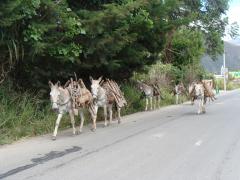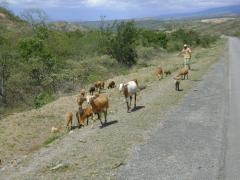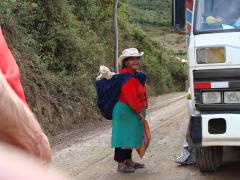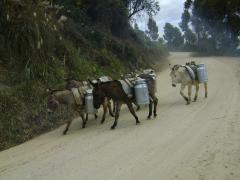Mountains and People: Perceptions of Northern Peru
Peru has some of the biggest mountains and deepest valleys we have encountered so far. We find it very interesting to ride the high mountains of Peru because the sierras are inhabited by indigenous people who live in the traditional ways they have maintained for centuries. Not much has changed in hundreds of years. In some areas we have been riding through there is no electricity, no running water, no paved road, lots of sheep, cows, chickens, donkeys which carry cargoes of milk, wood, heavy loads of vegetables like potatoes, corn and cabbage. The people themselves carry huge loads on their backs. The women wear the same traditional clothes they have for ages including special hats which identify the area they come from. Around Cajamarca the women wear short skirts with ballooning petticoats, tall, wide-brimmed hand-woven hats made of fine strands of straw. They all have wraps and ponchos to either keep warm or carry a load. They're even shorter than me. From the distance they sometimes remind me of the profile of Halloween witch The women in Northern Peru can be seen herding donkeys loaded with metal containers of milk, babies on their backs and walking along a high mountain road while spinning wool on a stick, preparing the wool for knitting or weaving. The women always have busy hands. Always. Where we are right now the women knit afghans of multiple colors, ponchos, and sweaters. If they don't have a baby on their backs they're carrying a load of firewood, twigs, or huge bunches of herbs and greens.
The men work hard in the high fields growing the family's food. We see the men toiling on the sides of mountains, leaning over for hours planting, weeding and harvesting. At other times times we see them leading teams of oxen plowing the fields. We also see groups of men herding horses or donkeys heavily loaded from the harvested fields. Once we saw a train of burros carrying massive white bags full of cabbage. When one of the animals finally descended to the road, it refused to go any further. We watched with terror as one young man tried to drag the animal up the last slope to the unloading place. It tried to kick but missed. His handler kicked and whipped him but the poor donkey would go no further. It just lay down in the middle of the road, along a dangerous curve. The young man was furious. He unloaded the cargo and dragged the animal to its feet with the help of another man. The poor thing still could not go any further. The did manage to get it to the side of the road behind the guardrail. They just left the animal there and carried the load up the mountain the rest of the way on their own backs. The horse was lame and hardly stand on any its own legs. It changed its weight from one leg to the other, obviously in pain and didn't even mosey the few yards remaining to the unloading area. It twitched and sweated trying to recover. I felt helpless, a bystander watching a hard fact of life in this area. The animals work as hard as the people themselves.
I am always amazed to see cultivation of fields which barely cling to the slope. Occasional we see collapsed slopes and the result. In one area we rode through a whole village was wiped out by a landslide. In some areas the only crop they grow for sale was coffee and in other areas they grow fruits, potatoes, rice, cabbage, wheat, beans, corn and various other legumes for exporting to other areas. Near Leymebamba it is the time of the year for cutting the corn, and we saw flocks of wild parrots who have emigrated here for this special harvest. Wild flocks of dozens green parrots flying up and down the canyon above the Utcubamba Rivers. The racket they make is an unforgettable sound. They are immigrants without papers.




